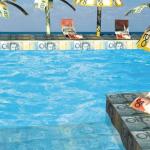East Africa is considered the homeland of the land snail Achatina. It grows up to 25 cm in length. In many countries of Europe and the CIS, the snail is kept as an exotic pet. It is not whimsical in care and does not require large financial costs for maintenance and feeding. Despite the seeming slowness to us, Achatina can move quickly, it is interesting to observe its movement.
Choose a ventilated snail container
Keep your pet Achatina in a well-ventilated glass terrarium (aquarium) or plastic container. Equipped with a secure lid with small holes.
To keep one snail, choose a container about 40 cm long, 25 cm wide and no more than 25 cm high.
Place the thermal mat and thermometer

The thermal mat is fixed on the rear outer wall or on the bottom of the terrarium. The thermometer is placed over a heat source. The optimum temperature for keeping home Achatina is 24-25 degrees.
A thermal mat in a terrarium is optional though.
Apply a thick layer of substrate

Use coco coir or flower soil free of fertilizers and pathogens as soil. Avoid sawdust, shells and pebbles.
Irrigate the soil and container walls with warm water

For a comfortable stay of a tropical snail, you need to irrigate the soil daily with warm settled water. To keep the humidity level at 60-70%. But don't turn the soil into mud. You can place a shallow container of water in the terrarium. Check humidity with a hygrometer.
Decorate your terrarium

Do not decorate the terrarium with stones and ceramics - the snail may fall and damage the shell on them.
Spread twisty branches in a container and make tussocks of moss. From half a plastic flower pot or a coconut, you will get a secluded place for your pet's daytime rest. Plant live plants in the ground, they will decorate your container and serve as additional food for Achatina.
Handle the snail carefully

Before handling Achatinas, make sure your palms are clean and damp. Wash your hands with warm water without soap, as sweat, soap or cream residue is harmful to the snail.
Try to take Achatina not by the shell, but under the sole. Best off the ground, never force it off the glass. Don't squeeze the shell too hard, you could crush it.
Feed the giant Achatina vegetables and herbs once a day

Such as cucumber, cabbage and lettuce. Be sure to wash all vegetables and fruits to remove chemicals. Feed in the evening. Remove any uneaten food the next day.
- For the growth of a beautiful and durable shell, the snail needs calcium. These are ground eggshells, edible chalk and sepia;
- the snail needs a shallow container with clean water.
Remove eggs from soil

If you don't want dozens or hundreds of baby snails, remove all eggs from the soil. Achatina eggs are white or translucent. Check the substrate every week for masonry. Freeze unwanted masonry in the freezer.
Wash the terrarium and change the substrate every week

With proper care, homemade Achatina does not get sick. It is very important that it does not come into contact with salt, sugar and chemicals, including fertilizers and pesticides.
If the terrarium is cold or hot, your snail becomes inactive and closes in the shell.
A healthy Achatina is active, its body is moist and clean, and the shell is strong without dents or chips.
- Place the terrarium away from direct sunlight, radiators and drafts.
- Place the mollusk in an accessible place.
- The African snail loves cucumbers and water and needs calcium for its shell.
- Cucumbers have almost no nutritional value for Achatina.
- Do not feed peaches to snails, because their mucus becomes like water.
- Don't leave moldy food in the terrarium.
- Always wash vegetables with warm water, you wash away chemicals that can kill your snail.
- Be careful when feeding Achatina with spinach, a large amount of it can interfere with the absorption of calcium.
- The diet of home Achatina should be varied.
Achatina snail is a land mollusk, in nature there are more than 60 species. Hermaphrodite. One clutch of Achatina can contain from 80 to 500 white eggs. After 14 days, pinhead-sized babies hatch from the masonry. There are also several types of viviparous Achatina, but the number of snails is much less.
Terrarium for newborn Achatina
Newborn snails do not need a large and spacious terrarium, as they may not find food. Therefore, an old aquarium or a food container of 8-10 liters will serve as a temporary home for babies.
Terrarium ventilation

In the first few months, it is important to maintain a constant temperature and humidity in the terrarium with small snails. To do this, place a thermometer and a hygrometer. The optimum temperature for keeping Achatina is 25 - 27 degrees. Optimum humidity 65% - 70%.
A thermal cord or incandescent lamp will help you maintain the temperature. Humidity - daily spraying with boiled water from a spray bottle.
Priming

For newborn Achatina, lettuce and cabbage leaves usually serve as soil. Kids sit on these leaves and eat, gaining strength.
If small snails are in a terrarium with soil, then give preference to a fine coco substrate and flower soil without fertilizers. It is better to refuse moss in the first months. Sand, stones and sawdust are strictly prohibited as soil. .
Where to put a terrarium with Achatina

Small snails, like adults, are afraid of direct sunlight, household heaters and drafts. Therefore, it is impossible to put a terrarium with Achatina on the windowsill or near the battery. The best place would be a cabinet or bookshelf in your room, or in the kitchen next to the kitchen table.
Feeding small snails
For the first few days, newborn Achatina feed on the remains of their eggshells. Therefore, it is enough to put a few lettuce leaves abundantly sprinkled with ground shells or edible chalk.

The taste habits of the Achatina snail are formed from childhood. Try to diversify the daily diet of your little pets.
In the first week, the diet of babies should be grated vegetables, chopped greens, calcium mixtures and grain mixtures. Calcium is essential for the growth and formation of a strong and beautiful shell. Vegetable protein helps healthy shellfish grow and develop faster. More recipes for rapid growth.

From the second week of a snail's life, add grated fruits and animal protein to your usual diet.
Starting from the age of one month, replace grated vegetables and fruits with chopped sticks and plates. Read more about feeding babies

From the age of two months, snails can be fed with all foods, like adult mollusks.

Do I need to water little Achatina.
After each meal, it is advisable to spray the walls of the terrarium with purified or boiled water. Babies will crawl on wet walls and drink drops of water. It is advisable to do this in the evening. Separately, you do not need to put a container with water for drinking snails. Until the kids grow up, it is enough to irrigate the terrarium daily.
Breeding of domestic land snails in our time is available to both people who are professionally involved in molluscs and beginners.
True, in pet stores it is rarely possible to meet a consultant who can provide qualified assistance in this matter.
In our article, we will look at how to properly keep snails at home.
Short description
Giant African snail, or Achatina- this is a new hobby for fans of shellfish, large ten times larger than usual (you can compare them in the photo), which can be grown at home. 
These snails belong to the Achatinidae family, which includes several genera and more than 60 species of these mollusks.
Achatina snails have an elongated and pointed top of the shell, which distinguishes them from fellow subspecies. They are very prolific, in one clutch there can be up to 500 eggs, similar to tiny chicken ones.  Achatina is considered the largest land snail, has a yellow-brown shell, the pattern on the shell is zigzag. The mollusk has a soft body, black or gray in color with small white tubercles.
Achatina is considered the largest land snail, has a yellow-brown shell, the pattern on the shell is zigzag. The mollusk has a soft body, black or gray in color with small white tubercles.
Did you know? It is known that the largest specimen of a land snail weighed 450 g, and the length of its shell was about 37 cm.
Benefits of keeping Achatina
The Achatina snail, according to mollusk breeders, is an ideal pet. Consider the main advantages of snails as pets:
- These creatures are not whimsical in care, they do not create noise.
- They are not intrusive, and you do not need to ask your acquaintances to sit with them when you are away.
- Achatina can live without you for two weeks.
- They breed successfully in captivity.
- Snails with good care can live up to 10 years.

Selection and arrangement of housing
Serves as a home for the snail terrarium container made of plastic or plexiglass. You can also use regular glass for. For a medium-sized snail, to make it feel comfortable, you need a terrarium with a volume of at least 3 liters. Therefore, if you are planning to start an Achatina family, take a larger container.
Or the terrarium should be equipped with special covers that have small holes. This is done so that Achatina does not run away, and at the same time there is air access.
substrate
The bottom of the terrarium, in which the snail will live, must be lined with a layer of substrate. For these purposes, you need to take flower compost without the addition of fertilizers or pure peat (but it can create a very acidic environment).
Soil is needed so that your snail can burrow into it during the day. It is necessary to ensure that the substrate is constantly moist, and wet it with water from a spray bottle at least twice a day. If the substrate is very dry, the snail will smear it with its mucus and get dirty, and the glass of the terrarium will also get dirty.
It is not recommended to use clay and fatty loams as a substrate; it is not necessary to add pieces of wood and bark to the soil. It is allowed to pour a little loose sand or hazelnut shells, or the core of a walnut. Nut shells are more convenient than ordinary soil, they do not get dirty, so you will need to clean the container less often.  However, flies can start in such a substrate, which are harmless to the pet, but will fly around the house.
However, flies can start in such a substrate, which are harmless to the pet, but will fly around the house.
Important! Regardless of the type of substrate, its thickness at the bottom of the container should be at least 4 cm.
Lighting
For a terrarium with this mollusk, no additional lighting. The intensity of light in no way affects the vital activity of mollusks. For them, the regular alternation of day and night is more important, since their main activity occurs at night, while during the day they like to hide in a layer of soil away from prying eyes and rest. The lighting of the terrarium is more necessary for the owner than for the mollusk.
Important!If you decide to light your pet's house, take the light outside the aquarium, because if the lamp is inside, the snail can crawl on it and damage the system, a short circuit may also occur and your pet may die.
Temperature
Since this species of snail is a tropical animal, it is used to living at high temperatures. The air in your terrarium will need to be warmed up to 20-28 °С. At this temperature, Achatina feel normal and are active.  But you should not try to heat the terrarium from direct sunlight or room heaters, as this will not end well - the mollusk may suffer from the temperature contrast in the room.
But you should not try to heat the terrarium from direct sunlight or room heaters, as this will not end well - the mollusk may suffer from the temperature contrast in the room.
Air humidity
Snails prefer a humid environment, so the humidity level should be at least 70%, but not more than 90%. At a sufficient air temperature, the moisture in the substrate evaporates and further humidifies the air, this must be taken into account. To increase the humidity, use a conventional household spray bottle. Humidity will be sufficient if the terrarium is regularly sprayed with water. You can also keep a container of water in the terrarium.
Additional accessories
In order to entertain Achatina, they use scenery for a terrarium. These can be pieces of wood, moss, non-sharp fragments of clay pots that will serve as a shelter for a pet and decorate the landscape. All of these decorations must be kept clean and safe.
Sometimes Achatina owners plant live plants in terrariums. They look beautiful and unusual in the snail's house. True, when watering plants, you need to ensure that the substrate is not waterlogged. If you are going to plant plants in a container, give preference to those with small villi. Try not to plant ferns and ivy, although these plants look beautiful, they will be quickly eaten by Achatina. 
Care and feeding
The larger the Achatina, the less often it is allowed to feed it, for example, once every few days. Small snails need to be fed once a day. These mollusks are vegetarians, for this reason they need to be provided with the most green plant foods. They should be fed only with approved products, combined with products that your particular Achatina loves.
Diet
Let's look at how to feed Achatina snails at home.
In their diet, you can include such products:
- cucumbers;
- zucchini;
- apples;
- spinach;
- corn;
- lettuce and tree leaves (not bitter);
- berries;
- mango;
- banana pulp.

What not to feed
- sharp;
- salty;
- sweet;
- smoked;
- fried;
- pasta;
- potato eyes;
- citrus fruits.
Water
Achatina not only eat, but also drink water, so always keep a container of clean water in a container. This container should not be very large, since Achatina can fall into it and drown. When your pet grows up, you can put a small pool in the terrarium, as snails love water, which they need to secrete mucus.
Nutritional supplements
For the rapid growth and development of mollusks, they need a source of calcium carbonate and vitamins. In the terrarium, you can put a piece of chalk, pour some eggshells. The chalk in the terrarium must be natural, as factory-made, chemically produced, will be ignored by the mollusk. You can purchase vitamin and mineral mixtures at pet stores, complexes made for reptiles are suitable. 
Terrarium cleaning
The procedure for cleaning the terrarium, depending on its filler, is carried out several times in three months. Cleaning the container consists of completely rinsing it (but do not use chemicals, use baking soda instead of powder) and replacing the substrate. Carry out unscheduled cleaning of the container if its walls are covered with mucus or an unpleasant odor emanates from it.
The snails themselves also do not mind swimming. This should be done with warm boiled water, carefully, under a gentle stream and without completely immersing the animal in water.  Thus, caring for Achatina snails at home does not require much effort.
Thus, caring for Achatina snails at home does not require much effort.
Did you know?Snails can carry on their shell a load that is 10 times their own weight.
Diseases: prevention and treatment
Snails are very tenacious, but in any case, you need to know how to help them. If your pet has a piece of the shell broken off - this is not a reason to panic. Lubricate the edges of the broken part of the sink with an antiseptic, make sure that the pet is in a clean and comfortable place. In the body of your pet, regeneration processes should start themselves, so the mollusk will survive if the infection has not entered the body. New fabrics will eventually tighten the chipped shell.
Another problem with these animals is that the Achatina likes to scrape its shell with a radula, which can cause a hole to be rubbed in it. In order to wean your pet from this activity, lubricate the sink with something unpleasant to taste, but safe. 
How many live at home
Is it possible to take
For the safety of the clam is better don't pick him up especially for the vulnerabilities of his body. But if you really want to take the pet in your arms, first wet his leg with water, then stick your finger under it, with your other hand you need to carefully hold the heavy sink.
African giant snails are the perfect pet for busy or lazy people who can forget about yt for a while. They are not whimsical enough in care and maintenance. They can be left unattended for a couple of weeks without fear for them. And if you keep them well, Achatina will be your pet for many years.
Today, Achatina snails are popular among people. They are bred as pets.
These mollusks look exotic, they require minimal care. They are quiet, non-aggressive and funny, able to please the eye and cheer up.
The Achatina snail is a gigantic snail found naturally in areas of the Republic of Kenya, Tanzania and parts of Asia.

Shellfish excellent adapt to adversity. In length, they reach 30 centimeters. African Achatina live on average from 5 to 9 years.
Body structure:
- Pharynx.
- Salivary gland.
- Intestines.
- Liver.
- Anal opening.
- A heart.
- Bud.
- Nerve knots.
- Oviduct.
- Flagellum.
- Protein gland.
- Sex hole.
Today large snails rank first in popularity among exotic lovers.
They are funny, do not require special attention from the owner, and keeping them at home consists only in proper nutrition and selection of suitable food.

The snail has a large brown shell. But its color changes depending on the food. These mollusks move quickly. In 1 minute, a snail covers a distance of 1 centimeter.
Content rules:
- Ideally snails placed in a square or rectangular terrarium. But if not, then use an aquarium or container.
The terrarium is selected based on the number of "inhabitants". For one land snail, you will need a terrarium of at least 10 liters.
The terrarium must be covered with a lid. This is done so that the land snail does not crawl out of it.
- The lighting is dimmed. If you make a bright light, then the inhabitant of the terrarium will go blind.
- The soil is made from a soft substrate: hazelnut shells, fallen leaves, forest cover moss, sphagnum moss.
Also suitable earth, neutralized peat, coco substrate. The minimum layer of soil is 10 centimeters. The snail lays eggs in the soil.
- Presence aeration (oxygen saturation).
- Temperature varies from 27 to 28 degrees Celsius.
Soft ground softens shellfish falling from the walls of the terrarium. If the bottom is not covered, then the shell will crack when it falls. Because of this, the mollusk dies.
Do not use sand or sawdust to line the bottom. They damage the shell.
Care rules:
- Daily spray the soil in the terrarium.
- Priming changes 2 times a week.
- Once a week the walls and bottom of the pet's habitat are cleaned with a brush.
- Once a month Achatina needs to be bathed. The pet bathes with pleasure.
To do this, take the snail in your hand and support it under a stream of warm water, then carefully clean the shell with a brush from dirt.

The terrarium is decorated with fresh and artificial flowers. Remember that fresh flowers are quickly eaten by pets, so it is better to use decorative ones.
Place a container of water to maintain a normal level of humidity inside the container. Achatina love to swim in containers with water. There must be a house.
Important! Do not settle Achatina in round terrariums.
The terrarium must not be placed in a place with direct sunlight. Ultraviolet has a negative effect on shellfish.
How to feed Achatina snails?
Achatina picky creatures. You can even not feed them for 2-3 weeks, but in this case the snail will fall into hibernation (a state in which life processes slow down).

In other words, suspended animation is hibernation. If they fell asleep, then you can wake them up only with the help of water.
What do Achatina eat:
- Apples.
- Pears.
- Apricots.
- Grape.
- Melon.
- Bananas.
- Watermelon.
- Papaya.
- Avocado.
- Pineapples.
- Sweet cherry.
- Cucumbers.
- Tomatoes.
- Carrot.
- Corn.
- Dill.
- Petrushka.
- Spinach.
- Celery.
- Dandelion leaves.
- Bread.
- Milk.
- Hercules.
- Boiled eggs.
- Crushed nuts.
Snail nutrition should not be uniform. Food leftovers are always removed to prevent mold and fungal growth.
To improve the color of the shell, Achatina are fed with carrots, pumpkins, sweet peppers, tomatoes, nettle leaves and plantain.
Reproduction: how to care for eggs?
Snails are hermaphrodites. They reach sexual maturity only after 7 months. Reproduction begins with mating dances. Achatina circle around each other.

Breeding process:
- Contact with copulatory organs.
- The incubation period is from 7 to 14 days.
- Laying 100 to 400 eggs in the ground.
- After 21 days, small snails hatch. The length of their body is from 3 to 5 centimeters.
Use in cosmetology: benefit or harm?
Today, molluscs are actively used in cosmetology. Scientists have found that Achatina mucus contains a lot of allantoin, elastin, collagen, peptides, glycolic acid and arahan sulfate.

Note! Many components of mucus perfectly rejuvenate the skin of a person's face.
Table: benefit
Usually the mucus of snails is not harmful. It is not recommended to use them in cosmetology for people with hypersensitivity, an allergic tendency.
Before the procedure with snails, apply some slime on your wrist to test for an allergen.
If the skin is covered with red spots, itches and itches, then it is undesirable to use snails.
In cosmetology, the massage procedure is very popular. The snail is washed and planted on the person's face for a certain time.
Massage helps:
- Narrow pores.
- Get rid of mimic wrinkles.
- Get rid of bags under the eyes.
- Prevent peeling of the skin.
- Increase the elasticity of the skin of the face.
Varieties
Over 60 varieties of Achatina live on the territory of the African continent. At home, it is customary to keep only a few species.

Kinds:
- Fulik.
- Reticulum.
- Immaculate.
- Albopicta.
- Iradelie.
- Brown.
- Tiger.
- Zanzibarica.
- Standard.
- Panther.
- White albino.
Snails are great pets for kids. Many children love to play with them, and parents may not worry that the pet will harm their baby.
Children are interested in naming Achatins, taking care of them. In reality, the snails are much more beautiful and larger than in the photo. They have a more pronounced color and a longer body.
Achatina snails are popular not only in real life, but in computer life. Today there is one game ARK: Survival Evolved, where these mollusks are the main characters.
Useful video
The first thing to take care of is to provide the snail with a spacious and well-equipped dwelling. This must be done in advance, and although the snail will feel good at first both in a container and in a three-liter bottle, it is still better to purchase a terrarium at a pet store. When choosing a dwelling, it should be borne in mind that the growth rate of the snail will also depend on its size: the larger the capacity for keeping the animal, the larger the adult Achatina will reach.
A very important point is the choice of soil for the Achatina snail. Here one should take into account the fact that snails eat the soil, passing it through themselves and extracting nutrients from the soil. Thus, soil purchased at a flower shop and enriched with fertilizers can lead to the painful death of an animal. Also, it is absolutely impossible to use sawdust, sand, stones as a soil for a terratium, since these fillers can seriously injure the snail. The most popular soil among the owners is the coconut substrate, sometimes mixed with peat. You can also use ordinary moss collected in a deciduous forest. Moss must be cleaned of debris, small insects, pour cold water and leave for 24 hours.
It is necessary to ensure good ventilation in the terrarium: an excess of fresh air leads to overdrying of the soil, a lack of it makes it too humid in the terrarium, and this is a favorable environment for the development of bacteria and fungi, including molds.
Also, the Achatina snail needs a balanced diet. A feature of these animals is that they will not eat bad food; a cucumber stuffed with nitrates will most likely remain untouched. Food should be varied, of good quality and always fresh. Achatina love apples, cucumbers, carrots, pumpkins, leafy vegetables, milk, cottage cheese, kefir or yogurt. Useful porridge made from oatmeal in water or milk, of course, not hot. In general, all products that you offer Achatina should be at room temperature, not cold.
There is a small list of products that are categorically prohibited in the diet of snails:
- First of all, it is salt and all artificially salted food. Salt will kill the animal.
- You can not treat your pet with food from your table, various smoked meats and marinades, fried, stewed or boiled dishes.
- Citrus fruits are also banned.
It is important to ensure that the snail gets enough calcium, especially during the period of active growth. The snail shell grows about 0.5 cm per week, so it is important to take care to provide your pet with this important macronutrient. It is quite simple to do this: the shell of raw, thoroughly washed chicken eggs is cleaned of the inner film, dried and ground into powder using an ordinary coffee grinder. You can also put a piece of white chalk or mineral sepia (cuttlefish shell) purchased at the pet store for birds in the terrarium.
drinker you can not put it, it’s enough to spray the walls of the terrarium with cold boiled water from a spray bottle once a day - this procedure will give the snail a drink, which will lick water drops from the glass walls, and maintain the optimal level of humidity in Achatina’s dwelling.
Achatina snails require careful handling: you can take the animal by the narrowest part of the shell, since the wide one during the growth period is soft and can be easily damaged. In no case should an animal sticking to the surface of an object be pulled by the shell, as it is possible to seriously, even fatally, injure the snail.
How to understand what my Achatina needs? Surprisingly, it is very easy to understand the needs of such an unusual silent and unhurried animal. The snail closed in its shell - lack of moisture in the terrarium, and if, on the contrary, Achatina hangs on the wall of the dwelling - an excess of moisture. It climbs onto the cover of the terrarium and hangs on it - most likely, the animal is experiencing stress. When Achatina is scared or hurt, she makes a loud whistling-hissing sound, similar to a scream. Such sounds should never be ignored. If the snail is not getting enough protein or is just hungry, it may not hurt, but sensitively bite. The snail's mouth, called the radula, is equipped with about 25,000 sharp teeth that look like a grater.
The benefits of Achatina snails. By the way, this special structure of the Achatina oral cavity has found wide application in modern cosmetology: milk is applied to the face skin cleansed of cosmetics and impurities. The snail, smelling it, works as a radula, simultaneously polishing the skin, thus removing its upper layer, along with skin imperfections in the form of small scars, pigment and age spots, freckles. At the same time, mucus, which contains collagen, has a healing effect on a rash of various etiologies, small scratches, cracks in the skin, as well as a rejuvenating effect. After the first procedures, small wrinkles are smoothed out, and subsequently deeper wrinkles become less and less noticeable.
It is believed that Achatina snails have a short memory and are not very smart. However, these cute animals soon get used to the owner, recognize his hands and do not hide when trying to stroke the snail. When unfamiliar hands approach them, Achatina try to immediately hide in their shell.





